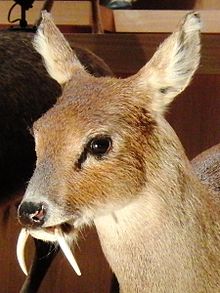Water deer
The water deer (Hydropotes inermis) is an even-toed ungulate mammal of the deer family. It is the only member of the subfamily Hydropotinae. There are two subspecies: the Chinese water deer (Hydropotes inermis inermis) and the Korean water deer (Hydropotes inermis argyropus).
| Water deer | |
|---|---|

| |
| Scientific classification | |
| Kingdom: | |
| Class: | |
| Order: | |
| Family: | |
| Genus: | Hydropotes
|
| Binomial name | |
| Hydropotes inermis | |

Appearance
changeWater deer are small deer: they are about 90 cm long and about 50 cm high. They weigh about 13 kg. The water deer has yellowish-brown fur, with a white chin and throat. Both males and females do not have antlers. Males have long upper canine teeth (called tusks), which can be up to 5 cm long.
Habitat
changeThe water deer originally lived in China and Korea. Today there are also small wild populations in England and France. Water deer live close to water: in swamps and on the shores of rivers and lakes.
Life
changeWater deer eat grasses and reeds. They also eat grains and vegetables from fields.
Water deer live alone, but sometimes they form small groups.
After a pregnancy of 200 days the female gives birth to 2-4 babies. A water deer baby has white dots and stripes on its fur, which disappear after 8 weeks. They drink milk for 3 months. When the young water deer are 6 months old they are independent and leave their mothers. They become mature when they are 1 year old.
